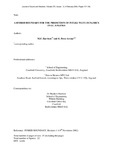- CERES Home
- →
- School of Engineering (SoE)
- →
- Staff publications (SoE)
- →
- View Item
JavaScript is disabled for your browser. Some features of this site may not work without it.
| dc.contributor.author | Harrison, M. F. | en_UK |
| dc.contributor.author | Perez Arenas, R. | en_UK |
| dc.date.accessioned | 2005-11-22T13:34:53Z | |
| dc.date.available | 2005-11-22T13:34:53Z | |
| dc.date.issued | 2004-02 | en_UK |
| dc.identifier.citation | M. F. Harrison and R. Perez Arenas, A hybrid boundary for the prediction of intake wave dynamics in IC engines, Journal of Sound and Vibration, Volume 270, Issues 1-2, 6 February 2004, Pages 111-136. | en_UK |
| dc.identifier.issn | 0022-460X | |
| dc.identifier.uri | http://hdl.handle.net/1826/769 | |
| dc.identifier.uri | http://dx.doi.org/10.1016/S0022-460X(03)00487-5 | |
| dc.description.abstract | This paper concerns the calculation of wave dynamics in the intake systems of naturally aspirated internal combustion (I.C.) engines. In particular it presents a method for improving the boundary conditions required to solve the one-dimensional Euler equations that are commonly used to describe the wave dynamics in time and space. A number of conclusions are reached in this work. The first relates to the quasi-steady state inflow boundary specified in terms of ingoing and outgoing characteristics that is commonly adopted for engine simulation. This is correctly specified by using the pair of primitive variables pressure (p) and density (ρ) but will be unrealistic at frequencies above a Hemholtz number of 0.1 as only stagnation values po, ρo are used. For the case of I.C. engine intake simulations this sets a maximum frequency of around 300Hz. Above that frequency the results obtained will become increasingly unrealistic. Secondly, a hybrid time and frequency domain boundary has been developed and tested against linear acoustic theory. This agrees well with results obtained using a quasi-steady state boundary at low frequencies (Helmholtz number less than 0.1) and should remain realistic at higher frequencies in the range of Helmholtz number 0.1 - 1.84. Thirdly, the cyclic nature of the operation of the IC engine has been exploited to make use of the inverse Fourier transform to develop an analytical hybrid boundary that functions for non-sinusoidal waves in ducts. The method is self starting, does not rely on iterations over complete cycles and is entirely analytical and therefore is an improvement over earlier hybrid boundaries. | en_UK |
| dc.format.extent | 1886 bytes | |
| dc.format.extent | 516096 bytes | |
| dc.format.mimetype | text/plain | |
| dc.format.mimetype | application/msword | |
| dc.language.iso | en_UK | en_UK |
| dc.publisher | Elsevier | en_UK |
| dc.title | A hybrid boundary for the prediction of intake wave dynamics in IC engines | en_UK |
| dc.type | Article | en_UK |
Files in this item
This item appears in the following Collection(s)
-
Staff publications (SoE) [603]
